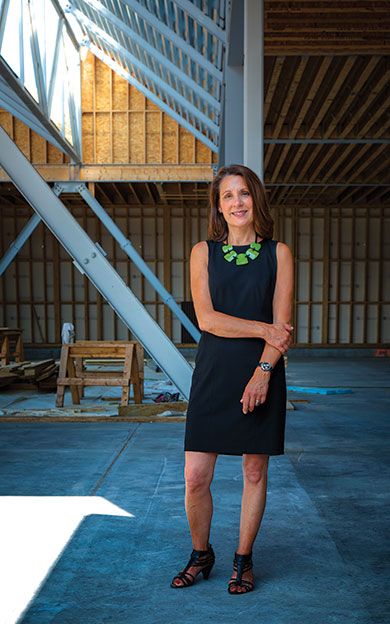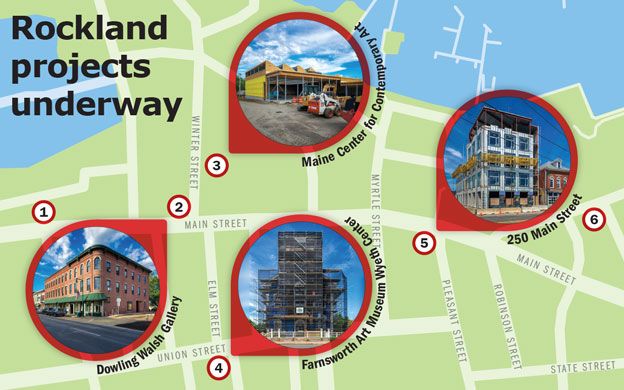Rock-solid resurgence: Rockland draws investors, new construction
Each summer, thousands of visitors and summer residents flock to downtown Rockland to enjoy lobster, blues, and boat festivals, to peruse galleries and shops, to see the renowned collection of American art at the Farnsworth Art Museum, or to explore Penobscot Bay.
Now, investors are pouring more than $20 million into a raft of projects that promise to make Rockland an even bigger draw for visitors and residents all year round and spark development in a corner of the working waterfront that has long been eyed for revival.
Ability to evolve
In addition to the influx of dollars and activity, the current wave of development promises to diversify the city's economy and make it less vulnerable to the fortunes of any one particular industry or company. Historically a hub for sardine canneries, seafood processing plants and limestone quarries, Rockland has absorbed waves of change as those industries faltered or disappeared altogether.
The entire region was buoyed by investments from MBNA, starting in the early 1990s. The Delaware-based credit card company brought 1,900 jobs to Belfast, and thousands of others throughout the state. What's more, it poured money into local community groups and institutions. In 2001, MBNA became the city's biggest taxpayer when it built a call center on Rockland's Water Street that created 300 jobs and revived a key section of the waterfront. MBNA closed the call center in 2005, in the wake of the bank's acquisition by Bank of America.
Boston Financial Data Services Inc. moved into the building in 2008 and created 200 jobs there and has plans to add up to 100 more positions.
“Rockland has gone through a number of evolutions,” says Gordon Page, executive director of Rockland Main Street Inc., a nonprofit representing businesses, residents and government in the city's downtown. “What's been unique is its ability to evolve over time and to adjust and modify itself to fit the needs of the community. We've continued to survive in a lot of different ways.”
As the ebb and flow of other industries continued, businesses related to the arts continued to flourish and grow into a major piece of the economy, buoyed by the Farnsworth — its collection of 15,000 works draws 65,000 visitors per year to its Rockland campus. The museum reaches 100,000 people a year through its outreach programs. The historic Strand Theatre was restored and reopend in 2005, and draws 40,000 people a year for movies, concerts and other performances. There are two dozen galleries just on Rockland's Main Street and just as many shops.
Page sees momentum continuing with the emergence of award-winning restaurants like Primo and Cafe Miranda. “It's just one thing after another that seems to be falling into place,” he says.
Audra Caler-Bell, Rockland's community development director, says she's particularly heartened that each of these projects is being driven by the organic growth of the institutions and entrepreneurs who are based here.
“It's all very sustainable,” she says. “It's home-grown businesses that have had a lot of success and are able to keep investing in the community.”
And other home-grown businesses, even those not based on Main Street, expect to benefit from the new development.
“With this new growth comes not only excitement and a renewed interest in the city of Rockland, but it also produces economic benefits to all businesses as more and more people decide to move here because of these new developments,” says Eliot Lowe, president of Lowe Hardware, which builds custom interior hardware for residential, commercial and marine use.
“That in turn increases local spending,” Lowe adds. “Even though our facility isn't located downtown, we still feel very much a part of this exciting new energy.”
Lowe, founded in 1982, last year doubled the size of its facility, adding space for manufacturing, offices and a product showroom. “We are fortunate that our current customers continue to give us more work,” Lowe says, “and that our customer base is continuing to grow steadily.
Growth coincidence, yet 'symbiotic'
Though these projects are being driven by each organization's individual needs and aspirations for growth, the investors hope and expect their collective efforts to benefit one another.
“It's a coincidence,” that all these projects are coming online at the same time, says Jacob Dowling, owner of the Dowling Walsh Gallery, “but it's symbiotic.”
The building planned behind his gallery will be used to manage, transport, facilitate and store collections for institutions and private collectors — a need Dowling has seen growing for about five years. There would also be the potential to provide a staging area for work awaiting installation.
“It's going to facilitate the institutions and the people who are at the core of this economic shift” in Rockland, he says. “It's going to allow them to work better and more efficiently.”
For the Center for Maine Contemporary Art, the new building in Rockland will offer nearly twice as much gallery space, plus the flexibility to house installations of any size. At the current site in Rockport, at 162 Russell St., the center has a shortage of gallery space, plus it's divided between two floors, says Director Suzette McAvoy.
Perhaps the biggest benefit of CMCA's new site will be location — and the opportunity to attract people who are visiting the other sites on Main Street. By moving to the heart of downtown, the CMCA will be within walking distance of the Farnsworth, Dowling Walsh Gallery, Lyman's new hotel and the Maine State Ferry Terminal. It can be a part of Art in Rockland's First Friday events. The facility is designed by award-winning New York-based architect Toshiko Mori and it will feature a 2,200-square-foot courtyard that opens directly on to the street.
“Just having foot traffic, will make a huge difference,” McAvoy says.
The new site in Rockland is expected to have 35,000 visitors within the first year of opening — nearly quadruple the 9,000 visitors that annually visit the Rockport site. McAvoy sees the new site as complementing the Farnsworth, The Strand Theatre and the commercial galleries.
“The real nexus of the art scene has moved definitively to Rockland,” she says. “With our new facility being located right nearby, it really provides this third leg of the stool to really anchor downtown and help create more of a year-round destination.”
Lyman is expecting the new hotel to provide needed accommodations to tourists and people who do business in the area year round. The hotel will be managed by Migis Hotel Group, which manages The Migis Lodge on Sebago Lake, The Black Point Inn in Scarborough and other properties.
“You've got really fantastic restaurants, great high-end art galleries, and we see a need for the hotel to meet their customers' needs,” says Lyman. “The galleries are doing well, CMCA could bring a significant amount of visitors to town. There's a lot of good things happening. Rockland is up and coming and we're hoping to be a part of it. ”
When the historic Kimball Block Building at 435 Main St. came on the market in 2013, Richard and Jennifer Rockwell were eager to seize on the opportunity to invest in the market in a way that could enhance Rockland's appeal as a destination to live and work.
“There's been such an influx of wonderful food and art in the downtown, and it's brought so many different types of people to the area,” says Jennifer Rockwell. “That alone, even without any of the development, was enough for us to want to be here and open this market.”
That influx of activity has created an appetite for fresh, fast food on Main Street, which she hopes her market and cafe can satisfy.
“There really is no shortage of fried food,” says Jennifer Rockwell. “But there was a gap in natural, healthy food. So many people wanted it, there was just nowhere to find it.”
Eventually, the Rockwells plan to convert the top floors of the building to apartments. And in a space that is adjacent to the market in the same building, they hope to open a pop-up shop for short-term rentals — say for artisans who want to show their wares, or out-of-town or online businesses that want to test the market. Richard Rockwell also bought and spent nearly $4 million renovating the nearby 449 Main St., which houses office space and 3Crow Restaurant & Bar. He also has an option to buy 429 Main St. Rockwell is working with the city on making improvements to the Thorndike parking lot, a city-owned lot between the buildings and the harbor.
“So much amazing stuff is happening in Rockland right now simultaneously,” Jennifer Rockwell says. “We really got in here at the perfect time.”
As for the Farnsworth, officials are eagerly awaiting all the new development.
“They'll be more great reasons for people to come here and visit what's turning into possibly the art capital of Maine,” Farnsworth spokesman David Troup says. “They'll be pouring into town right across the street. And having a downtown hotel just creates more space for people to come, visit and spend money in the shops, galleries, and gas stations. Everybody benefits.”
Ripple effect
This wave of development underway now has also ignited interest from investors in other pockets of the historic downtown, and the Tillson Avenue area, a stretch of warehouses, vacant lots, and city-owned properties between the downtown and the working waterfront.
City officials are negotiating with investors to bring a retail and office complex to the space on Tillson Avenue formerly occupied by Redlon and Johnson, which had a fire in June 2014 that damaged the building, Caler-Bell says. The plans could also include a multi-level parking garage on an adjacent city-owned parking lot. The city is also in discussions with investors about developing the Bicknell Building, Beggar's Wharf, 14 Wharf, 8 Lime Street and other smaller properties in the area, says Caler-Bell.
Energy Management Inc., the developers of Rumford Power and Cape Wind, are studying the feasibility of building a natural gas-fired heat and power plant on the property now occupied by Rockland city hall and the public works garage, near the border of Thomaston and Route 1. If the $160 million project moves forward, it would come online within five years, Caler-Bell says.
“A lot of activity is starting to pick up, and that's drawn some of the bigger high-value investments,” says Caler-Bell. “They see Rockland as an area that's an anchor for industry on the midcoast.”
Read more
Tillson Avenue in Rockland the newest site for redevelopment













Comments